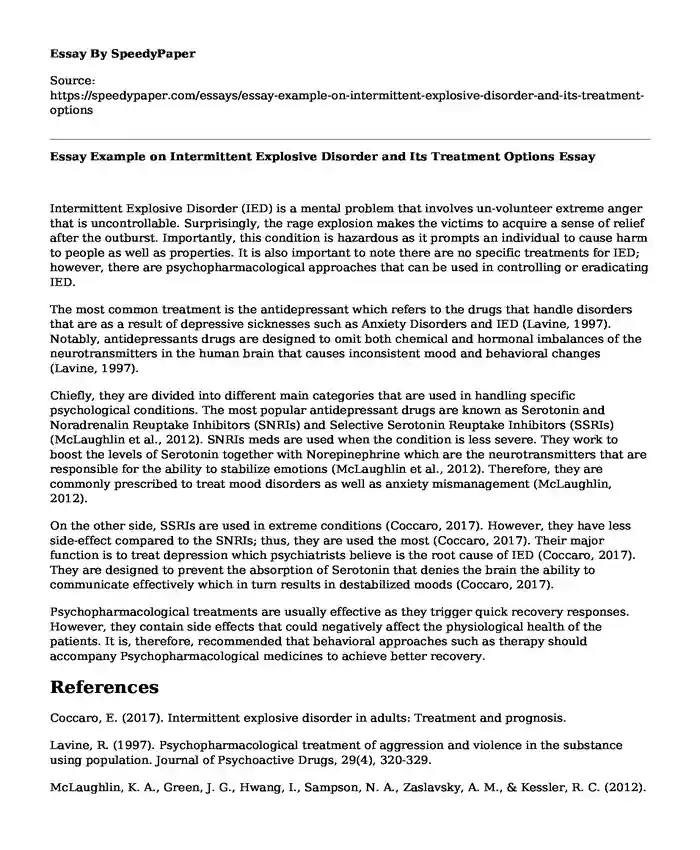
| Type of paper: | Essay |
| Categories: | Pharmacology Mental disorder |
| Pages: | 2 |
| Wordcount: | 403 words |
Intermittent Explosive Disorder (IED) is a mental problem that involves un-volunteer extreme anger that is uncontrollable. Surprisingly, the rage explosion makes the victims to acquire a sense of relief after the outburst. Importantly, this condition is hazardous as it prompts an individual to cause harm to people as well as properties. It is also important to note there are no specific treatments for IED; however, there are psychopharmacological approaches that can be used in controlling or eradicating IED.
The most common treatment is the antidepressant which refers to the drugs that handle disorders that are as a result of depressive sicknesses such as Anxiety Disorders and IED (Lavine, 1997). Notably, antidepressants drugs are designed to omit both chemical and hormonal imbalances of the neurotransmitters in the human brain that causes inconsistent mood and behavioral changes (Lavine, 1997).
Chiefly, they are divided into different main categories that are used in handling specific psychological conditions. The most popular antidepressant drugs are known as Serotonin and Noradrenalin Reuptake Inhibitors (SNRIs) and Selective Serotonin Reuptake Inhibitors (SSRIs) (McLaughlin et al., 2012). SNRIs meds are used when the condition is less severe. They work to boost the levels of Serotonin together with Norepinephrine which are the neurotransmitters that are responsible for the ability to stabilize emotions (McLaughlin et al., 2012). Therefore, they are commonly prescribed to treat mood disorders as well as anxiety mismanagement (McLaughlin, 2012).
On the other side, SSRIs are used in extreme conditions (Coccaro, 2017). However, they have less side-effect compared to the SNRIs; thus, they are used the most (Coccaro, 2017). Their major function is to treat depression which psychiatrists believe is the root cause of IED (Coccaro, 2017). They are designed to prevent the absorption of Serotonin that denies the brain the ability to communicate effectively which in turn results in destabilized moods (Coccaro, 2017).
Psychopharmacological treatments are usually effective as they trigger quick recovery responses. However, they contain side effects that could negatively affect the physiological health of the patients. It is, therefore, recommended that behavioral approaches such as therapy should accompany Psychopharmacological medicines to achieve better recovery.
References
Coccaro, E. (2017). Intermittent explosive disorder in adults: Treatment and prognosis.
Lavine, R. (1997). Psychopharmacological treatment of aggression and violence in the substance using population. Journal of Psychoactive Drugs, 29(4), 320-329.
McLaughlin, K. A., Green, J. G., Hwang, I., Sampson, N. A., Zaslavsky, A. M., & Kessler, R. C. (2012). Intermittent explosive disorder in the national comorbidity survey replication adolescent supplement. Archives of general psychiatry, 69(11), 1131-1139.
Cite this page
Essay Example on Intermittent Explosive Disorder and Its Treatment Options. (2022, Dec 27). Retrieved from https://speedypaper.net/essays/essay-example-on-intermittent-explosive-disorder-and-its-treatment-options
Request Removal
If you are the original author of this essay and no longer wish to have it published on the SpeedyPaper website, please click below to request its removal:
- Free Essay Example about Military Robots on the Grounds
- Essay Sample on Health Maximization: Free Sample to Check
- Free Essay: Influence of Native American Religions on the Religiosity of New World Settlers
- Free Essay on a Gap Year: High School Graduates Should Take a Year Off Before Entering College
- Essay Sample on Tactical and Strategic Goals
- Essay Sample on Termination of Therapy
- Free Paper Sample on Protz Hand Sanitizer
Popular categories




